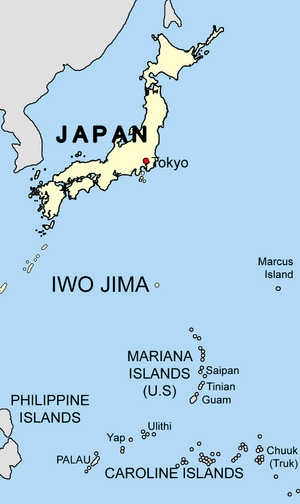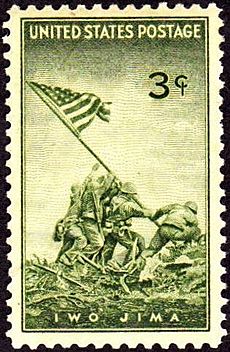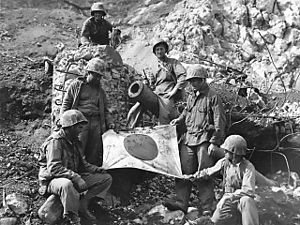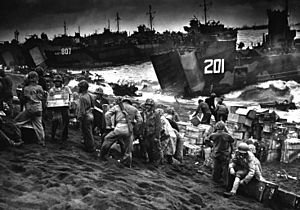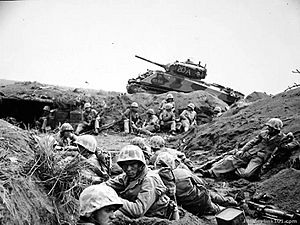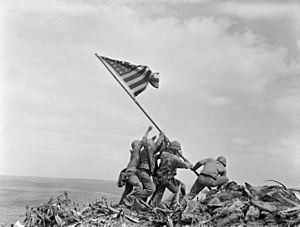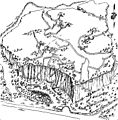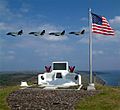Battle of Iwo Jima facts for kids
Quick facts for kids Battle of Iwo Jima |
|||||||
|---|---|---|---|---|---|---|---|
| Part of World War II, Pacific War | |||||||
 A U.S. 37 mm (1.5 in) gun fires against Japanese cave positions in the north face of Mount Suribachi |
|||||||
|
|||||||
| Belligerents | |||||||
| Commanders and leaders | |||||||
| Holland Smith Marc Mitscher |
Tadamichi Kuribayashi † | ||||||
| Strength | |||||||
| 70,000 | 18,061–18,591 | ||||||
| Casualties and losses | |||||||
| 12,822 killed/missing 19,217 wounded |
17,845–18,375 killed/missing 216 captured |
||||||
The Battle of Iwo Jima was the American capture of the Japanese island of Iwo Jima during the Pacific Campaign of World War II. The USA needed to capture Iwo Jima to be able to defeat Japan.
It lasted from 19 February – 26 March 1945. It was major battle in which the United States Armed Forces captured the island of Iwo Jima from the Japanese Empire.
The Americans wanted to capture the island, including its three airfields, and use this area for attacks on the Japanese main islands. This five-week battle had violent fighting.
After suffering such heavy losses, people questioned why the US went into the battle. The island was not useful for the Navy or Air Force.
The Imperial Japanese Army had thick defenses and underground tunnels for cover. The Americans had ships that could fire on the island and total control of the air. This invasion was the first American attack on Japanese home territory.
The Japanese general, Tadamichi Kuribayashi, and his soldiers refused to surrender. He and his officers said they would fight until they died.
There were 22,000 Japanese soldiers on Iwo Jima at the beginning of the battle, and only 216 were taken prisoner at the end.
About 3,000 Japanese soldiers kept fighting for weeks.
With no retreat and no possibility of reinforcements, the Japanese had dug in and prepared to fight to the death. This meant that winning the battle meant the Americans would have to destroy the entire Japanese force stationed on the island.
Many films were made about battle.
Contents
Background
After the Americans captured the Marshall Islands in January 1944, the Japanese military leaders thought about their situation.
It looked like the Americans would go toward the Mariana Islands and the Carolines. The Imperial Japanese Army and the Imperial Japanese Navy (I.J.N.) set up a line of defences.
In March 1945, the Japanese 31st Army, commanded by General Hideyoshi Obata, was ordered to defend this line.
The commander of the Japanese group on Chichi Jima was placed in command of Army and Navy units in the Volcano Islands. The Americans had started bombing Japan every day after they captured the Marianas. The Japanese were using Iwo Jima to transmit radio reports of American bomber activity.
After the U.S. captured bases in the Marshalls in February 1944, Japanese Army and Navy troops were sent to Iwo Jima. Iwo Jima had more than 5,000 men.
The loss of the Marianas during the summer of 1944 made the Japanese worried about the Volcano Islands. They knew that the Americans could launch airattacks on Japan if these islands were captured. However, it was hard for Japan to defend the Volcano Islands because the Imperial Japanese Navy had lost almost all of its ships.
Japan could not build new airplanes until March or April 1945. Even then, these planes could not fly to Iwo Jima from Japan. Japan did mot have enough pilots and other aircrew.
Iwo Jima was important for two reasons: it was an air base for Japanese fighter planes, and it was a safe place for Japanese ships. In addition, it was used by the Japanese to do air attacks on the Mariana Islands.
Capturing Iwo Jima would deny the air base from the Japanese and provide a place from which to launch the invasion of Japan.
When the US decided to invade Iwo Jima, experts thought it would be captured in one week, but hundreds of tons of Allied bombs had not harmed the entrenched Japanese defenders.
Planning and preparation
Japanese preparations
By June 1944, Lieutenant General Tadamichi Kuribayashi was ordered to defend Iwo Jima. He knew that Japan could not win the battle, but hoped to inflict enough casualties to dissuade the Allies from invading Japan.
Kuribayashi created strong defences with heavy weapons such as heavy machine guns and artillery. Extensive tunnels were dug, and Land mines were placed all over the island.
The amphibious landing
Starting on 15 June 1944, the U.S. Navy and the U.S. Army Air Forces began to attack the island. Naval artillery shellings and air bombings were done for nine months. Each heavy warship fired for approximately six hours.
These efforts failed to achieve desired effects due to the Japanese defenses. The American bombings continued until 19 February 1945: the day the Marines landed on the island.
About 450 American ships were near Iwo Jima. The battle involved about 60,000 U.S. Marines.
At 08:59, 30,000 Marines began landing on the island. The Japanese held their fire for some time while men and material began to fill the beaches. Then the Japanese opened fire, and many in the first group of Marines were killed by the machine guns.
Japanese heavy artillery was protected by steel doors that closed to protect the guns between shots. This made it difficult for American units to destroy Japanese artillery. The Japanese soldiers hid in the tunnel system.
With tanks, naval artillery, and air bombing on Mount Suribachi, the Marines were able to get past the beaches. About 40,000 more Marines landed later.
The fighting on Iwo Jima was very violent. The Marines’ advance was stopped by defensive positions and artillery. The Marines used flamethrowers and grenades to kill Japanese troops in the tunnels.
Eight Sherman M4A3R3 medium tanks with a flamethrower destroyed Japanese defences. The Japanese ran out of water, food, and supplies. The Japanese made more nighttime attacks. Most Japanese soldiers fought to the death.
Raising the flag
"Raising the Flag on Iwo Jima" is a photograph taken on 23 February 1945 by Joe Rosenthal. It shows five Marines and a U.S. Navy corpsman raising the flag of the United States on Mount Suribachi. The photograph was popular. It won a Pulitzer Prize for Photography.
The Japanese troops stayed in the tunnels. They were all killed.
Northern Iwo Jima
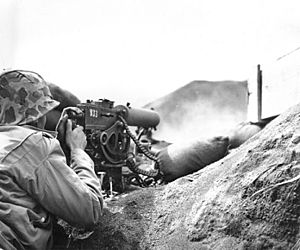
The Japanese still held positions on the north end. Kuribayashi had eight infantry battalions, a tank regiment, two artillery battalions, and three heavy mortar battalions. He also had about 5,000 gunners and naval infantry.
The Marines' tanks were destroyed by Japanese fire and mines. Many Americans were killed or wounded.
The Marines attacked in the darkness with no bombing before the attack. Many Japanese soldiers were killed while still sleeping.
On the evening of 8 March, Captain Samaji Inouye and his 1,000 men attacked the Americans causing 347 casualties (90 deaths). The Marines counted 784 dead Japanese soldiers the next day.
There was also a kamikaze air attack on the ships anchored at sea on 21 February. This sunk the escort carrier USS Bismarck Sea and severely damaged the USS Saratoga. There was minor damage to the escort carrier USS Lunga Point, an LST, and a transport.
On 16 March, Kuribayashi's soldiers were still alive on the northwestern end of the island. On 21 March, the Marines blew up the Japanese with four tons of explosives. On 24 March, Marines sealed up the caves.
A 300-man Japanese force attacked Airfield No. 2. There was a 90-minute fight and it suffered heavy casualties (53 killed, 120 wounded). The island was finally captured at 09:00 on 26 March.
Weapons
In the Pacific the United States used the M2 flamethrower. These flamethrowers were used to kill Japanese in caves. Marines also had flamethrowers on tanks which were used during battle. They were less useful because of Iwo Jima's rough land. Many other infantry weapons were utilized, including the infamous M1 Garand.
Aftermath
Of the 22,060 Japanese soldiers on the island, 18,844 died. Only 216 were captured during the battle. After Iwo Jima, 3,000 hid in the tunnels.
The 36-day battle for Iwo Jima resulted in more than 26,000 American casualties, including 6,800 dead. By comparison, the 82-day battle for Okinawa resulted in casualties of over 62,000, of whom over 12,000 were killed or missing. Iwo Jima was also the only U.S. Marine battle where the Americans suffered more casualties than the Japanese.
Because they had all been removed, there were no civilian casualties at Iwo Jima, unlike at Saipan and Okinawa.
Strategic importance
Given the number of casualties, the importance of the island's capture is controversial.
Iwo Jima was not used by the US Army Air Corp to drop the atomic bombs on Japan. Tinian was the Island both bombers left to bomb Hiroshima and Nagasaki, which were 12 hours out and back.
The argument for capturing Iwo Jima was that it provided a landing and refueling airfield for fighter escorts. Yet, only ten missions were ever flown from Iwo Jima.
Japanse fighter aircraft based on Iwo Jima sometimes attacked US forces. Only 11 B-29s were lost.
The Japanese on Iwo Jima had radar and could notify Japanese forces at home of B-29 Superfortresses flying from the Mariana Islands.
However, the capture of Iwo Jima did not affect the Japanese radar system.
Legacy
The United States Navy has several ships of the name USS Iwo Jima.
On 19 February 1985, the 40th anniversary of the landings, an event called the Reunion of Honor was held. The veterans of both sides who fought in the battle of Iwo Jima attended the event. A memorial was built. Representatives of both countries shook hands.
The importance of the battle to Marines today can be seen. Marines go to the island and to the summit of Suribachi.
The Japanese government continues to search for the bodies of Japanese military troops who were killed during the battle.
Medal of Honor awards
The Medal of Honor is the highest military decoration awarded by the United States government. It is given to a member of the United States armed forces who show bravery and risks his life in a battle. The medal is often awarded after death. It has been given only 3,464 times.
During this one-month-long battle, 27 U.S. military personnel were given the Medal of Honor for their actions, 14 of them after death.
Movies and documentaries
- To the Shores of Iwo Jima, a 1945 American documentary produced by the United States Navy, Marine Corps and the Coast Guard.
- Glamour Gal, a 1945 film about Marine artillery.
- Sands of Iwo Jima, a 1949 American film starring John Wayne.
- The Outsider, a 1961 film starring Tony Curtis as the conflicted flag raiser Ira Hayes.
- Flags of Our Fathers and Letters from Iwo Jima are two 2006 films directed by Clint Eastwood. Flags of Our Fathers is filmed from the American perspective and is based on the book by James Bradley and Ron Powers (Flags of Our Fathers). Letters from Iwo Jima (originally titled Red Sun, Black Sand) is filmed from the Japanese perspective.
- Part 8 of the 2010 HBO miniseries The Pacific, produced by Tom Hanks and Steven Spielberg, includes part of the battle of Iwo Jima from the point of view of a Marine who died there.
- Episode 23 from the 1973 Thames Television Documentary The World at War.
- Battle Rats: Iwo Jima (2009) (TV).
- The movie "The League of Grateful Sons" by Vision Forum concerns the Battle of Iwo Jima
Interesting facts about the Battle of Iwo Jima
- The battle was made famous by Joe Rosenthal's photograph of the raising of the U.S. flag on top of the 166 m (545 ft) Mount Suribachi. This photo became an important image of this battle, of the war in the Pacific, and of the Marine Corps.
- The battle lasted 36 days
- An extensive tunnel system was dug by the Japanese which was around 11 miles (17.7 kms) long and land mines were also placed all over the island.
- Iwo Jima island became an emergency landing site after the battle for the rest of the war.
- There were two Japanese soldiers who managed to hide on the island for 6 years!
- The Americans outnumbered the Japanese soldiers by more than 3:1.
- 6,800 Americans and 18,844 Japanese soldiers died at Iwo Jima.
Images for kids
-
The U.S. Marine Corps War Memorial in Arlington with the Washington Monument and the United States Capitol in the distance.
See also
 In Spanish: Batalla de Iwo Jima para niños
In Spanish: Batalla de Iwo Jima para niños


